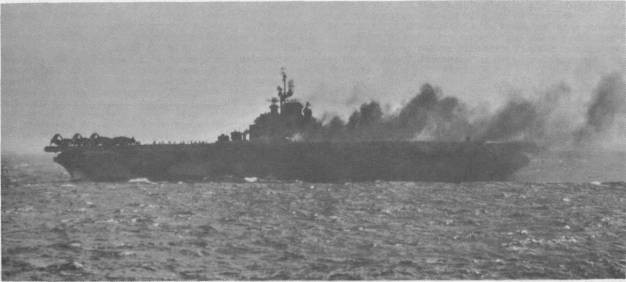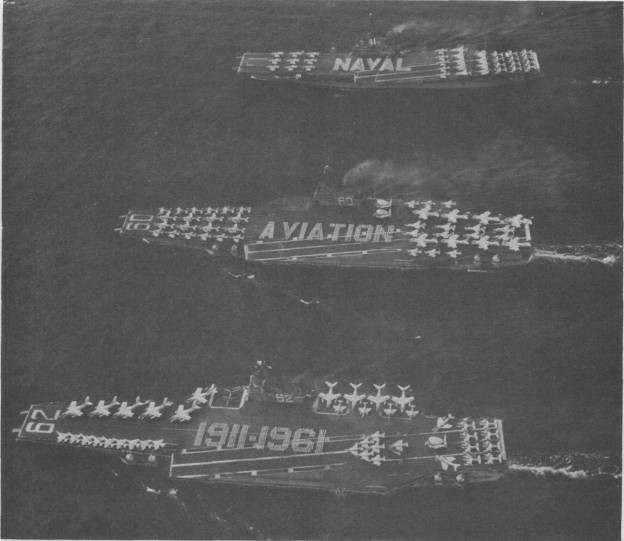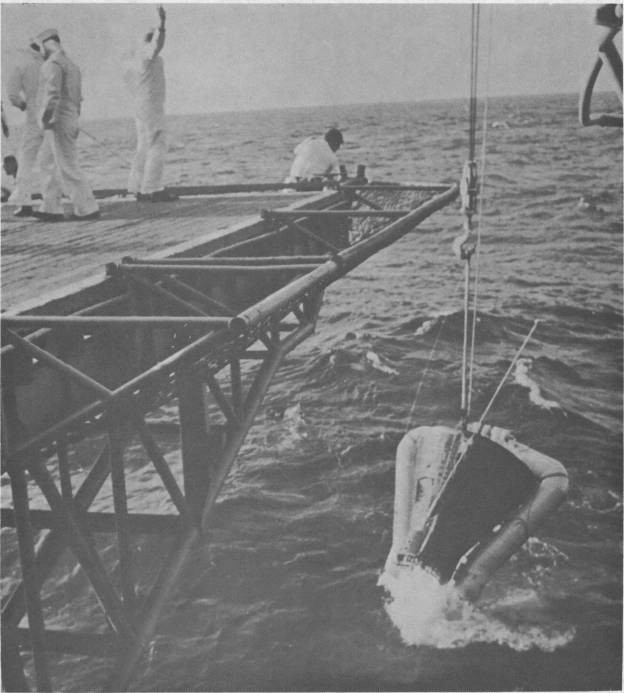Intrepid IV (CV-11)

(CV-11: dp. 27,100; l. 872'; b. 147'6"; dr. 28'7"; s. 33 k; cpl. 3,448; a. 12 5", 68 40mm., over 80 ac.; cl. Essex)

Fearless, brave.
IV
The fourth Intrepid was launched 26 April 1943 by Newport News Shipbuilding & Dry Dock Co., Newport News, Va.; sponsored by Mrs. John Howard Hoover; and commissioned 16 August, Captain Thomas L. Sprague in command.
After training in the Caribbean Intrepid departed Norfolk 3 December 1943 for San Francisco, then to Hawaii. She arrived Pearl Harbor 10 January and prepared for the invasion of the Marshall Islands, the next objective in the Navy's mighty island-hopping campaign. She sortied from Pearl Harbor with carriers Cabot and Essex 16 January to raid islands at the northeastern corner of Kwajalein Atoll 29 January 1944 and pressed the attack until the last opposition had vanished 2 February. The raids destroyed all of the 83 Japanese planes based on Roi and Namur before the first landings were made on adjacent islets 31 January. That morning Intrepid's planes strafed Ennuebing Island until 10 minutes before the first Marines reached the beaches. Half an hour later that islet, which protected Roi's southwestern flank and controlled the North Pass into Kwajalein Lagoon, was secured, enabling Marines to set up artillery to support their assault on Roi.
Her work in the capture of the Marshalls finished, Intrepid headed for Truk, the tough Japanese base in the center of Micronesia. Three fast carrier groups arrived undetected daybreak the 17th, sinking two destroyers and 200,000 tons of merchant shipping in 2 days of almost continuous attacks. Moreover, the carrier raid demonstrated Truk's vulnerability and thereby greatly curtailed its usefulness to the Japanese as a base.
The night of 17 February 1944 an aerial torpedo struck Intrepid's starboard quarter, 15 feet below her waterline, flooding several compartments and jamming her rudder hard to port. By racing her port screw and idling her starboard engine, Captain Sprague kept her on course until 2 days later strong winds swung her back and forth and tended to weathercock her with her bow pointed toward Tokyo. Sprague later confessed: "Right then I wasn't interested in going in that direction." At this point the crew fashioned a jury-rig sail of hatch covers and scrap canvas which swung Intrepid about and held her on course. Decorated by her crazy-quilt sail, Intrepid stood into Pearl Harbor 24 February 1944.
After temporary repairs, Intrepid sailed for the West Coast 16 March and arrived Hunter's Point, Calif., the 22d. She was back in fighting trim 9 June and departed for 2 months of operations out of Pearl Harbor, then to the Marshalls.
Intrepid's planes struck Japanese positions in the Palaus 6 and 7 September concentrating on airfields and artillery emplacements on Peleliu. The next day her fast carrier task force steamed west toward the southern Philippines to strike airfields on Mindanao 9 and 10 September. Then, after raids on bases in the Visayan Sea 12 through 14 September, she returned to the Palaus 17 September to support Marines in overcoming fanatical opposition from hillside caves and mangrove swamps on Peleliu.
When the struggle on that deadly island settled down to rooting Japanese defenders out of the ground on a man to man basis, Intrepid steamed back to the Philippines to prepare the way for liberation.
She struck throughout the Philippines, also pounding Okinawa and Formosa to neutralize Japanese air threats to Leyte.

As Intrepid's planes flew missions in support of the Leyte landings 20 October 1944, Japan's Navy, desperately striving to hold the Philippines, was converging on Leyte Gulf from three directions. Ships of the U.S. Navy parried thrusts in four major actions collectively known as the Battle for Leyte Gulf.
The morning of 24 October, an Intrepid plane spotted Admiral Kurita's flagship, Yamato. Two hours later, planes from Intrepid and Cabot braved intense antiaircraft fire to begin a day-long attack on Center Force. Wave after wave followed until by sunset American carrier-based planes had sunk mighty battleship Musashi with her mammoth 18-inch guns and had damaged her sister ship Yamato along with battleships Nagato and Haruna and heavy cruiser Myoko forcing the latter to withdraw.
That night Admiral Halsey's 3d Fleet raced north to intercept Japan's Northern Force which had been spotted off the northeastern tip of Luzon. At daybreak the tireless fliers went aloft to attack the Japanese ships then off Cape Engano. One of Intrepid's planes got a bomb into light carrier Zuiho to begin the harvest. Then American bombers sank her sister ship Chitosi, and a plane from either Intrepid or San Jacinto scored with a torpedo in large carrier Zuikaku knocking out her communications and hampering her steering. Destroyer Ayitsuki went to the bottom and at least 9 of Ozawa's 15 planes were shot down.
On through the day the attack continued and, after five more strikes, Japan had lost four carriers and a destroyer.
The still potent Center Force, after pushing through San Bernardino Strait, had steamed south along the coast of Samar where it was held at bay by a little escort carrier group of six "baby flattops", three destroyers, and four destroyer escorts until help arrived to send it fleeing in defeat back towards Japan.
As Intrepid's planes hit Clark Field 30 October a burning kamikaze crashed into one of the carrier's port gun tubs killing 10 men and wounding 6. Soon skillful damage control work enabled the flattop to resume flight operations.
Intrepid's planes continued to hit airfields and shipping in the Philippines.
Shortly after noon 25 November a heavy force of Japanese planes struck back at the carriers. Within 5 minutes 2 kamikazes crashed into the carrier killing 6 officers and 59 bluejackets. Intrepid never lost propulsion nor left her station in the task group; and, in less than 2 hours, had extinguished the last blaze. The next day, Intrepid headed for San Francisco, arriving 20 December for repairs.
Back in fighting trim in mid-February 1945, the carrier steamed for Ulithi, arriving 13 March. The next day she pushed on eastward for powerful strikes against airfields on Kyushu, Japan, 18 March. That morning a twin engine "Betty" broke through a curtain of defensive fire, turned toward Intrepid and exploded only 50 feet off Intrepid's forward boat crane. A shower of flaming gasoline and plane parts started fires on the hangar deck, out damage control experts quickly snuffed them out.
Intrepid's planes joined attacks on remnants of the Japanese fleet anchored at Kure damaging 16 enemy naval vessels including super battleship Yamato and carrier Amagi. Then the carriers turned to Okinawa as D-Day of the most ambitious amphibious assault of the Pacific war approached. Their planes lashed the Ryukyus 26 and 27 March, softening up enemy defensive works. Then, as the invasion began 1 April, they flew support missions against targets on Okinawa and made neutralizing raids against Japanese airfields in range of the embattled island.
During an air raid 16 April, a Japanese plane dove into Intrepid's flight deck forcing the engine and part of her fuselage right on through, killing 8 men and wounding 21. In less than an hour the flaming gasoline had been extinguished, and only 3 hours after the crash, planes were again landing on the carrier.
The following day, Intrepid retired homeward via Ulithi and Pearl Harbor arriving San Francisco 19 May for repairs.
Intrepid stood out of San Francisco 29 June and enlivened her westward voyage 6 August as her planes smashed Japanese on bypassed Wake Island. The next day she arrived Eniwetok where she received word 15 August to "cease offensive operations."
The veteran carrier got under way 21 August to support the occupation of Japan. She departed Yokosuka 2 December and arrived San Pedro, Calif., 15 December 1945.
Intrepid shifted to San Francisco Bay 4 February 1946. Her status was reduced to "in commission in reserve" 15 August before decommissioning 22 March 1947 and joining the Pacific Reserve Fleet.
Intrepid recommissioned at San Francisco 9 February 1952 and got underway 12 March for Norfolk. She decommissioned in the Norfolk Naval Shipyard 9 April 1952 for conversion to a modern attack aircraft carrier. Re-classified CVA-11 1 October, she recommissioned in reserve 18 June 1954. She became the first carrier in history to launch aircraft with American-built steam catapults 13 October 1954. Two days later she went into full commission as a unit of the Atlantic Fleet.
After shakedown out of Guantanamo Bay 1955, Intrepid departed Mayport, Fla., 28 May 1955 for the first of two deployments in the Mediterranean with the 6th Fleet, mainstay in preventing Communist aggression in Europe and the Middle East. She returned to Norfolk from the second of these cruises 5 September 1956. The carrier got under way 29 September for a 7-month modernization overhaul in the New York Navy Yard, followed by refresher training out of Guantanamo Bay.
Boasting a reinforced angle flight deck and a mirror landing system, Intrepid departed the United States in September 1957 for NATO's Operation "Strikeback", the largest peacetime naval exercise up to that time in history. Operating out of Norfolk in December she conducted Operation "Crosswind", a study of the effects of wind on carrier launches. Intrepid proved that carriers can safely conduct flight operations without turning into the wind and even launch planes while steaming downwind.
During the next 4 years Intrepid alternated Mediterranean deployments with operations along the Atlantic coast of the United States and exercises in the Caribbean. On 8 December 1961 she was reclassified to an antisubmarine warfare support carrier, CVS-11. She entered the Norfolk Navy Yard 10 March 1962 to be overhauled and refitted for her new antisubmarine warfare role. She left the shipyard 2 April carrying Air Antisubmarine Group 56.
After training exercises, Intrepid was selected as the principal ship in the recovery team for Astronaut Scott Carpenter and his Project Mercury space capsule. Shortly before noon of 24 May 1962, Carpenter splashed down in Aurora 7 several hundred miles from Intrepid. Minutes after he was located by land-based search aircraft, two helicopters from Intrepid, carrying NASA officials, medical experts, Navy frogmen, and photographers, were airborne and headed to the rescue. One of the choppers picked him up over an hour later and flew him to the carrier which safely returned him to the United States.
After training midshipmen at sea in the summer and a thorough overhaul at Norfolk in the fall, the carrier departed Hampton Roads 23 January 1963 for warfare exercises in the Caribbean. Late in February she interrupted these operations to join a sea hunt for Venezuelan freighter, Anzoategui whose mutinous second mate had led a group of pro-Castro terrorists in hijacking the vessel. After the Communist pirates had surrendered at Rio de Janeiro, the carrier returned to Norfolk 23 March 1963.
Intrepid operated along the Atlantic Coast for the next year from Nova Scotia to the Caribbean perfecting her antisubmarine techniques. She departed Norfolk 11 June 1964 carrying midshipmen to the Mediterranean for a hunter-killer at sea training with the 6th Fleet. While in the Mediterranean, Intrepid aided in the surveillance of a Soviet task group. En route home her crew learned that she had won the coveted Battle Efficiency "E" for antisubmarine warfare during the previous fiscal year.
Intrepid operated along the East Coast during the fall. Early in September she entertained 22 NATO statesmen as part of their tour of U.S. military installations. She was at Yorktown 18 to 19 October 1964 for ceremonies commemorating Lord Cornwallis's surrender 183 years before.
During a brief deployment off North Carolina, swift and efficient rescue procedures on the night of 21 November 1964 saved the life of an airman who had plunged overboard while driving an aircraft towing tractor.
Early the next year Intrepid began preparations for a vital role in NASA's first manned Gemini flight. On 23 March 1965 Lt. Comdr. John W. Young and Maj. Virgil I. Grissom in Molly Brown splashed down some 50 miles from Intrepid after history's first controlled re-entry into the earth's atmosphere ended the pair's nearly perfect three-orbit flight. A Navy helicopter lifted the astronauts from the spacecraft and flew them to Intrepid for medical examination and debriefing. Later Intrepid retrieved Molly Brown and returned the spaceship and astronauts to Cape Kennedy.
After this mission Intrepid entered the Brooklyn Navy Yard in April for a major overhaul to bring her back to peak combat readiness.
This was the final Fleet Rehabilitation and Modernization (FRAM) job performed by the New York Naval Shipyard, Brooklyn, N.Y., slated to close after more than a century and a half of service to the nation. In September, Intrepid, with her work approximately 75 percent completed, eased down the East River to moor at the Naval Supply Depot at Bayonne, N.J., for the completion of her multi-million dollar overhaul. After builder's sea trials and fitting out at Norfolk she sailed to Guantanamo on shakedown.
Mid-1966 found Intrepid with the Pacific Fleet off Vietnam. Here her gallant pilots delivered powerful blows for freedom and scored what is believed to be one of the fastest aircraft launching times recorded by an American carrier. Nine A-4 Skyhawks and six A-l Skyraiders, loaded with bombs and rockets, were catapulted in 7 minutes, with only a 28-second interval between launches. A few days later planes were launched at 26-second Intervals. After 7 months of outstanding service with the 7th Fleet off Vietnam, Intrepid returned to Norfolk having earned her Commanding Officer, Captain John W. Fair, the Legion of Merit for combat operations in Southeast Asia.
In June 1967, Intrepid returned to the Western Pacific by way of the Suez Canal just prior to its closing during the Israeli-Arab crisis. There she began another tour with the 7th Fleet to safeguard the peace and freedom of the world, for, as Daniel Webster said in 1834, "God grants liberty only to those who love it, and are always ready to guard and defend it."


